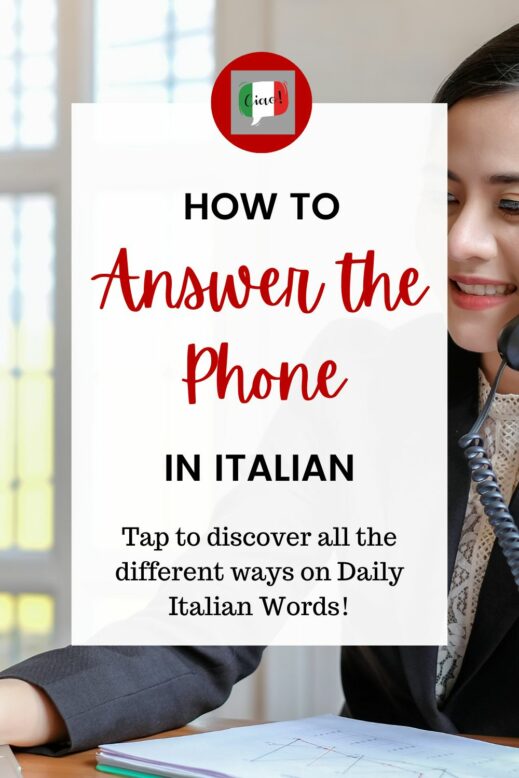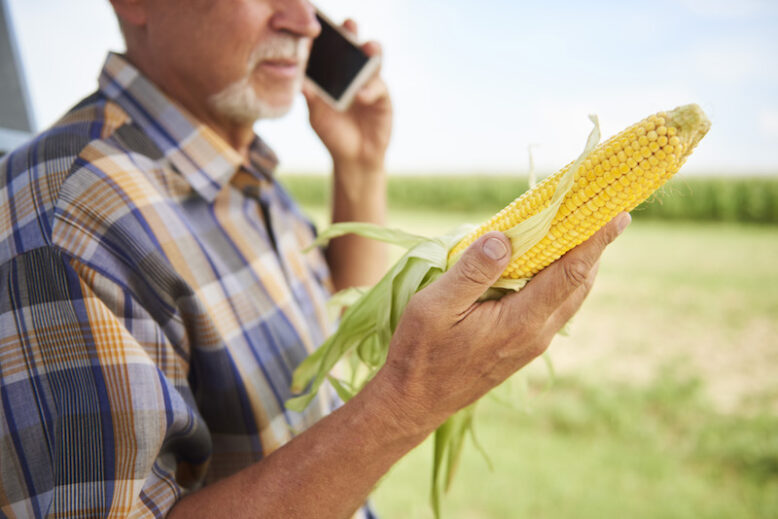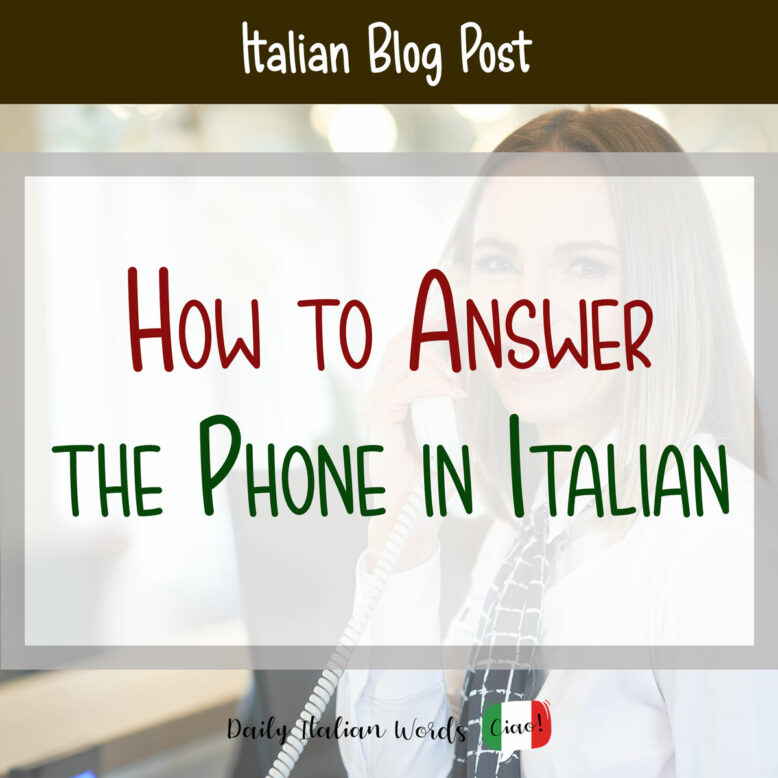Answering the phone in a language that’s not your native one can be pretty intimidating, right? It’s just you and the voice on the other end, with no facial expressions or hand gestures to lean on. This takes me back to my first time picking up a call in English – boy, was I a bundle of nerves!
But no need to worry! In this article, I’ll walk you through the proper ways to answer the phone in Italian. Whether it’s catching up with your ever-so-charming friend in Rome or making a reservation at that quaint trattoria in Florence, I’ll help you make your Italian phone chats sound natural.

How to answer the phone in Italian as the recipient
Answering the phone in Italian is super simple – whenever the phone rings, just say “pronto.” It translates to “ready” in English, so think of it as if you’re saying, “Hey, I’m all ears!“.

This cool little word has some interesting stories behind it. Some believe it started way back when phones were a new thing and there were operators connecting callers to recipients. Once the connection was established, these operators would say “pronto” to signal, “Go ahead, start talking.” Others think the origin of “pronto” dates back to military habits, as the first uses of the telephone occurred in the military field, and “pronto” was used to indicate that one was ready to intervene.
You could also jazz up “pronto” with a few extra words, for example:
- “Pronto, chi parla?” (Hello, who’s speaking?) to immediately find out who is on the other side of the line.
- “Sì, pronto?” (Yes, hello?), a simple yet effective way to say you’re listening.
- Or mix them up: “Sì, pronto, chi parla?” (Yes, hello, who’s speaking?).
Note: Remember that “pronto” is gender-neutral, so you don’t have to change it to “pronta” if you are a woman.
If you know who’s calling, you can get a bit more personal:
- For your buddies or family, go with “ciao [name],” like “Ciao Luca” (Hello Luca) or “Ciao ma” (Hello mom).
- In more formal situations, use “buongiorno/buonasera [name],” like “Buongiorno Signor Bianchi” or “Buonasera Dottore”
- And if it’s your friend or family member who keeps calling, a quick “Sì?“ (Yes?) or “Sì, dimmi” (Yes, tell me) will do. Just save this for people you know well to avoid sounding a bit too sharp.
How to answer the phone in Italian as the caller
When you’re the one initiating a phone call in Italian, you have several ways to respond after hearing the receiver say “pronto.” Below are some examples of both informal and formal responses. As you will see, you can choose to use “pronto” in your reply or omit it.

Informal contexts
“Pronto, ciao [name]” or “Pronto, ciao [name], sono [your name]”
For example:
“Pronto, ciao, sono Valentina!” (Hello, hey it’s Valentina!).
“Pronto, ciao Anna, sono Valentina” (Hello, hey Anna, it’s Valentina).
“Ciao [name]” or “Ciao [name], sono [your name]”
For example:
“Ciao, sono Valentina!” (Hey, it’s Valentina!).
“Ciao Anna, sono Valentina” (Hi Anna, it’s Valentina).
Formal ways
“Pronto, buongiorno/buonasera, sono [your name]” or “Pronto, Buongiorno/Buonasera, mi chiamo [your name]”.
For example:
“Pronto, buongiorno, sono Valentina Nicastro, chiamo per…” (Hi, good morning, I’m Valentina Nicastro, I’m calling to…).
“Pronto, buonasera, mi chiamo Valentina Nicastro, chiamo per…” (Hi, good evening, my name is Valentina Nicastro, I’m calling to…).
“Sì, buongiorno/buonasera, sono [your name]” or “Sì, Buongiorno/Buonasera, mi chiamo [your name]”.
For example:
“Sì, buongiorno, sono Valentina Nicastro, chiamo per…” (Yes, good morning, I’m Valentina Nicastro, I’m calling to…).
“Sì, buonasera, mi chiamo Valentina Nicastro, chiamo per…” (Yes, good evening, my name is Valentina Nicastro, I’m calling to…).
“Buongiorno/Buonasera, sono [your name]” or “Buongiorno/Buonasera, mi chiamo [your name]”.
For example:
“Buongiorno, sono Valentina Nicastro, chiamo per…” (Good morning, I’m Valentina Nicastro, I’m calling to…).
“Buonasera, mi chiamo Valentina Nicastro, chiamo per…” (Good evening, my name is Valentina Nicastro, I’m calling to…).
“Salve” (Hi), can be used as an alternative to “Buongiorno/Buonasera,“ and is suitable for any time of the day.
Some examples:
“Sì pronto, salve, sono Valentina Nicastro, potrei parlare con la signora Paola Rossi, per favore?” (Yes, hi, I am Valentina Nicastro, may I speak with Mrs. Paola Rossi, please?).
“Sì, salve, sono Valentina Nicastro, parlo con Paola Rossi?” (Yes, hi, I am Valentina Nicastro, am I speaking with Paola Rossi?).
“Salve, sono Valentina Nicastro, sto cercando la dottoressa Paola Rossi.” (Hi, I am Valentina Nicastro, I am looking for Dr. Paola Rossi.).
“Salve, è la trattoria Rossi?” (Hi, is this the Trattoria Rossi?).
After your introduction, you can continue the conversation with questions or statements like:
- “Mi scusi se la disturbo, avrei bisogno di…” (Excuse me if I am disturbing you, I need to…)
- “Vorrei sapere / parlare con…“ (I’d like to know / speak to…)
- “Sto chiamando per…“ (I’m calling to…)
- “È possibile parlare con qualcuno che…” (Is it possible to speak to someone who…)
How to wrap up a phone call in Italian
Understanding how to properly end a phone conversation is as crucial as knowing how to initiate one. In Italy,“Ciao” / “Ciao ciao” (informal) and “Arrivederci” (formal) are a classic, but there are also other expressions that can be used.

For casual chats with friends and family, you can also sign off with these phrases:
- “Ciao, a presto” (Bye, see you soon)
- “Ci sentiamo” (We’ll hear from each other, implying ‘Let’s keep in touch‘)
- “Grazie per la telefonata” (Thanks for the call), a sweet note like the one grandmas always use.
- “Ora devo scappare/andare” (I need to run/go now), perfect for when you’re in a rush or, let’s be honest, when you need a polite excuse to hang up!
In more formal situations, like business calls, try these polished goodbyes:
- “Grazie, arrivederci” (Thank you, goodbye) or ”Grazie mille, arrivederci!” (Thank you very much, goodbye)
- “Grazie, a risentirla!” (Thank you, I look forward to hearing from you again!)
- “Grazie per …. [l’aiuto, le informazioni, ecc.], arrivederci”. (Thank you for… [the help, the information, etc.], goodbye) to show appreciation.
Examples of answering the phone in Italian
Let’s now have a look at some practical examples of phone calls in Italian.

Example 1 – Say you’re on a road trip through Tuscany and you decide to stay overnight in a village recommended by a restaurant manager where you had lunch. You call a local hotel, and the conversation likely unfolds as follows:
HOTEL: Pronto, buongiorno, Hotel Rossi, come posso aiutarla? (Hello, good morning, Hotel Rossi, how can I help you?)
YOU: Buongiorno, avete una camera disponibile per questa sera? (Good morning, do you have a room available for tonight?)
HOTEL: Un momento per favore, controllo la disponibilità. Desidera una camera singola o doppia? (One moment please, I’ll check. Would you like a single or double room?)
YOU: Una camera doppia, per favore. (A double room, please.)
HOTEL: Perfetto. Sì, abbiamo disponibilità, il costo è 70 euro. Posso avere il suo nome, per favore? (Perfect. Yes, we have availability, the cost is 70 euros. May I have your name, please?)
YOU: Certo, Mario Bianchi. (Sure, Mario Bianchi.)
HOTEL: Grazie, Signor Bianchi. La sua prenotazione è confermata. Ci vediamo stasera. (Thank you, Mr. Bianchi. Your reservation is confirmed. We’ll see you tonight.)
YOU: Grazie mille, arrivederci! (Thank you very much, goodbye!)
Example 2 – Your Italian friend, whom you met during your last trip to Italy, calls you. Recognising the number, you answer enthusiastically:
YOU: Ciao, Marco! Come stai? (Hello, Marco! How are you?)
MARCO: Ciao! Sto bene, grazie. E tu? Come va? (HelloI! I’m good, thank you. And you? How’s life?)
YOU: Tutto a posto, grazie. Sto già pianificando il prossimo viaggio in Italia! (All good, thanks. I’m planning another trip to Italy.)
MARCO: Fantastico! Quando pensi di venire? (Fantastic! When are you thinking of coming?)
YOU: Probabilmente a maggio. Spero di visitare Napoli questa volta. Hai qualche consiglio? (Probably in May. I hope to visit Naples this time. Do you have any tips?)
MARCO: Certo! Napoli è piena di posti meravigliosi. Ti manderò un elenco di ristoranti e luoghi da non perdere. (Of course! Naples is full of wonderful places. I’ll send you a list of restaurants and must-see locations.)
YOU: Sarebbe fantastico! E spero che possiamo incontrarci mentre sono lì! (That would be great! And I hope we can meet up while I’m there!)
MARCO: Sicuramente! Fammi sapere appena hai definito tutto. (Definitely! Let me know your plans as soon as you have planned everything.)
YOU: Lo farò. Grazie mille, Marco. A presto! (I will. Thanks a million, Marco. See you soon!)
MARCO: Prego! Ci sentiamo allora! (You’re welcome! Let’s keep in touch, then!)


Valentina Nicastro is a travel writer in love with her home country, Italy. Having travelled widely around the globe, she realised there was more to explore closer to home and decided to put the passport aside for a while. When she is not immersed in documenting Italy, you’ll find her donning her communication consultant hat, weaving words as a content writer and bridging linguistic divides as a translator.


